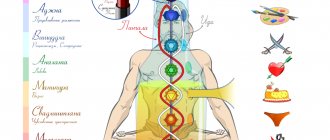The famous Italian writer Gianni Rodari, using a romantic comparison, showed how the association is formed. He compared the spoken word to a stone thrown into a river. The stone made waves on the water, which made everything in it sway: a leaf, a reed, a water lily, a fishing rod float. Only waves from the spoken word arise in our cerebral cortex; what you hear evokes images, memories, thoughts.
In the dictionary D.N. Ushakova
ASSOCIATION, associations, women. (from Latin associo - unite). 1. someone or something. The same as a joint union, society, partnership (as applied to some organizations). Russian Association of Scientific Research Institutes. 2. what and what, what with what, between what and what. The connection between individual ideas, by virtue of which one idea causes another (psych.). Association by similarity. Association of word sounds with meanings. Association of word sounds and meanings. Association between sounds and meanings.
Use of association methods in psychodiagnostics
Associative connections can be used in psychodiagnostics to study human mental states. Scientists became interested in this problem at the dawn of psychology as a science. Thus, Sigmund Freud, one of the founders of the science of the unconscious, believed that the subconscious contains repressed desires and instincts of a person that contradict the demands of society. These repressed desires are driven into the “very corner of the brain,” but they do not disappear completely and continue to influence a person’s thinking and behavior. He develops certain phobias, he does strange things, he even develops mental and physical illnesses. Repressed desires, as Freud believed, can be identified using associative diagnostics.
Associative connections arise spontaneously and carry information about existing suppressed instincts and desires. Freud used the method of free association, which is still used today. The identified associative connections allow the specialist to make an accurate diagnosis.
This method is very simple, although it looks strange. The patient should sit comfortably, relax and talk about anything. At the same time, he speaks exclusively about what first comes to his mind.
Currently, some psychologists do not use free associative connections, but rather more organized and controlled ones by a specialist.
To identify associative connections, specialists analyze many aspects of the patient’s life. This is, for example, creativity. When a subject draws a scene, he will certainly use the associative connections that arise.
Of particular interest for study is associative thinking. It is often opposed to logical thinking, and there are certain reasons for this. This kind of thinking allows you to quickly connect information from different areas to solving a problem. This type of thinking acts as if bypassing logic. The solution to the problem in this case can be not only faster, but also deeper, and the approach to this solution can be non-standard.
Associative thinking can be developed, and in the modern world it is advisable to do this. Psychologists have developed many techniques for developing associative thinking skills.
This attention to this type of thinking is explained, in particular, by the fact that logical methods are relatively simple, and at the present stage of human development it is often necessary to solve more complex problems; In addition, logical thinking is increasingly becoming the prerogative of computers, and therefore people are moving on to solving issues where a machine is fundamentally unable to cope. However, researchers nowadays are trying to teach artificial intelligence associative thinking, and there have already been some successes in this direction.
Associative thinking is the area in which human individuality is most clearly manifested. Since most associative connections are of deeply “personal” origin. In our time, one might say, the very understanding of the essence of man is changing. If previously it was customary to hide and suppress personal experience in order to better comply with “social norms,” today it is the personal approach to various things that becomes more profitable. In the future, it is quite possible that a person in his activities will be guided mainly by associative thinking.
In the Encyclopedia Dictionary
in psychology - a connection that arises under certain conditions between two or more mental formations (sensations, motor acts, perceptions, ideas, etc.); the basic concept of associative psychology. Associations are distinguished by contiguity (in space or time), similarity and contrast. The term was introduced by J. Locke (1698).—plant, the main classification unit of plant communities (phytocenoses). Characterized by a certain floristic composition. The association is named according to the dominant species of one or several layers, for example. in the forest there is a spruce-blueberry association - union, association.
Association as a form of association of legal and (or) individuals
A synonym for the word “association” is “union”, i.e. An association can be considered as a kind of organization that unites its members under certain conditions.
Therefore, formally, an association can be called any community of people or organizations that strive to achieve a common goal.
For example, grandmothers who gather every day on a bench at the entrance to chat. Their goal is to get some air and discuss their neighbors and the state of the world. Therefore, the collective of these grandmothers can be considered an association.
But it should be noted that the concept of “association” in Russian is used only as a designation of an alliance based on something more important than communication between grannies.
What is an association in business terms?
An association is a non-profit voluntary association of enterprises and/or individuals to achieve certain goals.
Goals can be very diverse:
- economic.
In this case, enterprises unite to effectively coordinate their actions in order to maximize profits, improve production conditions, and protect common interests.Within the framework of the assigned tasks, members of the association deepen the specialization of each individual participant, expand cooperation, and lobby their interests in government agencies.
Now the same thing in simple words: let’s say there are farmers Ivanov, Petrov and five more of the same workers who operate legally (individual entrepreneurs, LLCs, etc.). They are engaged in growing potatoes. Problems are pouring in from all sides: loans are not given, the village council is trying to cut down land plots, spare parts for equipment are impossible to get.
And so all these village workers decide to unite their efforts to overcome various obstacles by creating and officially registering their union - association. Each of the farmers delegates their powers to the association and calmly goes about their direct business - growing potatoes.
The association, on behalf of its members, solves their problems: receives a bank loan, issues spare parts at a discount, hires a lawyer to solve problems with land plots, expands the sales market, etc.
Real example: “Russian Union of Industrialists and Entrepreneurs” (RSPP):
- scientific _ Membership in such associations is based on scientific activity. For example, the association “Man, Culture, Society”, a public organization that unites supporters of the integration of humanities;
- Humanities . Example - “Russian Library Organization”. This is the unification of libraries into one organization in the interests of the development of librarianship in the Russian Federation;
- public _ An example is the World Association of Women Entrepreneurs. The members of this international organization are successful women entrepreneurs from more than 60 countries.
The activities of associations in the Russian Federation are regulated at the legislative level:
- Civil Code (Articles 123.8 – 123.11);
- Law “On Non-Profit Organizations”;
- Law “On State Registration of Legal Entities and Individual Entrepreneurs”.
The principles underlying the activities of associations:
- members of associations can be commercial or non-profit organizations, or citizens;
- the maximum number of members of the association is not limited, the minimum is 2 members;
- statutory documents – Charter and constituent agreement;
- the highest governing body – the general meeting of members;
- daily activities are carried out by a collegial (council, board, presidium, etc.) or sole executive body (president, chairman, etc.) elected by the general meeting;
- if the members of the association decide that it will conduct commercial activities, then the association will have to change its organizational and legal form to a business company or partnership;
- the association can be transformed into a public organization or foundation;
- each member of the association upon joining it retains its financial and legal independence;
- members of the association have the right to leave its ranks at any time;
- the association is not responsible for its members;
- members of the association bear subsidiary liability for the obligations assumed by the association, if this is stated in its Charter. The amount of financial liability is fixed in the organization’s statutory documents;
- members of the association are required to pay membership fees provided for by the Charter.
In the dictionary Dictionary of foreign words
and, f.
1. Association of persons or institutions of the same type of activity. Sociological a. A. nuclear physicists.||Cf. CONFEDERATION" title='CONFEDERATION, CONFEDERATION is, what is CONFEDERATION, CONFEDERATION interpretation'>CONFEDERATION.
2. psychol. A relationship between separate representations, in which one of the representations causes another. A. by similarity.
3. chem. Combining molecules (or ions) into doubled, tripled, etc. aggregates, as well as such aggregates themselves.||Cf. DISSOCIATION" title='DISOCIATION, DISSOCIATION is, what is DISSOCIATION, DISSOCIATION interpretation'>DISSOCIATION.
4. astr. A cluster of young stars, indicating the ongoing process of star formation in the Galaxy.
5. bot A set of homogeneous plant communities with the same composition of plant species and with similar relationships both between organisms and between them and the environment.
Share the meaning of the word:
The meaning of the word "association"
association
1. whom, what, an association of persons, institutions, organizations, etc. to achieve a common goal ◆ The principle of association
here, despite all the protests, one must certainly remain on the sidelines:
association
can only be realized by combining the interests of unequals, seeking in mutual assistance the greatest possible benefit, but the benefit is not the same for everyone.
P.V. Annenkov, “Notes on the French Revolution of 1848”, 1848 (quote from NKRY) ◆
She also listened attentively to workers’
associations F. M. Dostoevsky, “Crime and Punishment”, 1866 ◆ I noticed that such individuals are found not in one nation, but in all societies, classes, parties, magazines and associations
.
F. M. Dostoevsky, “Notes from the House of the Dead,” 1862. ◆ Throughout Central Asia, trade is carried out by the natives together, by more or less significant associations
of traders. N. Petrovsky, “Letter to Stremoukhov”, 1871 (quote from NKRY)
2. psychol. a natural connection that arises in the experience of an individual between two contents of consciousness (sensations, ideas, thoughts, feelings, etc.), which is expressed in the fact that the appearance in the consciousness of one of the contents entails the appearance of the other ◆ We do not remember that experienced in infancy, not because they were not aware of it at the time they experienced it, but because they did not have such definite associations
traces that could be remembered.
K. D. Ushinsky, “Man as a subject of education. Experience of pedagogical anthropology”, 1867 (quote from NKRY) ◆ Usually there is no direct logical connection between individual pseudohallucinatory images, so neither external nor internal association
is seen here.
V. H. Kandinsky, “On Pseudohallucinations”, 1886 (quote from NKR) ◆ And what about love? Is it really a product of an association
of ideas?
Tell me frankly: have you ever loved? A.P. Chekhov, “Drama”, 1887 (quote from NKRYA) ◆ As soon as I think about our nursery, immediately, due to the inevitable association
of ideas, I begin to smell a special smell - a mixture of incense, wood oil, May balm and fumes from a tallow candle.
S. V. Kovalevskaya, “Memories of Childhood”, 1890 (quote from NKRYA) ◆ Nikolai Apollonovich, lowering his eyes to the plate, expelled from memory boring associations
: the Neva sunset and the inexpressibility of pink ripples, the most delicate reflections of mother-of-pearl, bluish-green depth;
and against the backdrop of the most delicate mother-of-pearl... Andrei Bely, “Petersburg”, 1913-1914 (quote from NKRYA) ◆ A man of evil will always say that “good” is a relative concept, but a suffering person will never say the same in relation to evil. We are now using very primitive and flexible concepts; this is nothing, since association
and around two short words a lot of ideas are in full swing.
A. S. Green, “Man with Man”, 1913 (quote from NKRY) ◆ The word translucent has three bright semantic elements: “half”, “through”, “look”, and therefore is highly expressive in a word, rich in complex associations
. L. V. Shcherba, “Experiences in linguistic interpretation of poems: “Memoirs” of Pushkin,” 1922 (quote from NKR)
3. in statistics, the degree to which changes in one variable are accompanied by changes in another
4. program in [[OOP]] the most abstract semantic connection indicating the type of relationship between classes ◆ Without associations
the system turns into a set of isolated single classes. S. A. Orlov, “Software Development Technologies”, 2012
Types of associations
To find associations, there are several ways to build associative links between any objects:
- Contiguity in time or space: table and chair, winter and snow;
- Similarity (similarity): earth and ball, lamp and pear;
- Contrast (opposite): good and evil, black and white;
- Causal relationships: thunder and lightning, lamp and light;
- Generalization: tomato and vegetable, dog and animal;
- Submission: vegetable and cucumber, animal and cat;
- Subordination to one object: car and motorcycle;
- Part and whole: seconds and minutes, car and engine;
- Addition: toothpaste and toothbrush.
Depending on the application of these methods, as well as on various modifications and conditions of their use, different types of associations can be found. For example, associations are:
- thematic, in which objects are related to a single theme (marketing and advertising);
- phonetic, in which there is consonance between objects (lie and rye, night and daughter);
- word-forming, based on the unity of the root or other parts of the word (laziness and laziness).
It is worth noting that the associative processes occurring in our consciousness depend on the degree of participation of different sensory organs in them. Thus, visual, auditory, kinesthetic, gustatory and olfactory associations are distinguished. Depending on a person’s predisposition and the characteristics of his sensory representational system, it will be useful for him to build associations that are suitable specifically for him.
Some people have motor memory, like Napoleon (who wrote down each new name three times, threw away the note and remembered the name forever). Some people, due to their developed auditory memory, prefer to speak information out loud. The basis of memory for people tuned to visual perception (and these are the majority) is, for example, the purposeful highlighting of key words in the memorized text (underlining, coloring, creating diagrams and drawings).
With the development of memory techniques, people have already developed associative techniques that are suitable for most of us. These techniques are called mnemonics, and they will be discussed in one of the following lessons.
Reorganization
The association may be reorganized into various forms of non-profit organizations.
When reorganizing this entity, all documents that are significant are transferred to the state, namely to the archives
If there are any, documents with information about personnel are also transferred to the state. When transferring documents, in which they will be stored must be met
The liquidation of an association occurs either by a court decision or by a decision of its members. In case of liquidation, a special commission is appointed, which sets deadlines and determines the procedure for liquidation.
Property
The association's property is formed from the proceeds of the founders, voluntary contributions and income received from securities, deposits and shares in which funds were previously invested.











